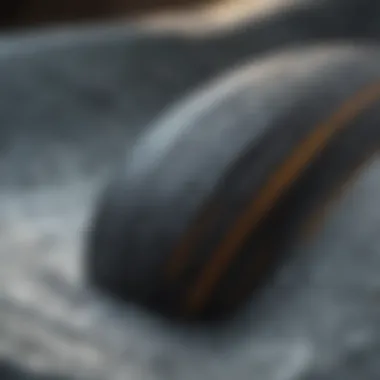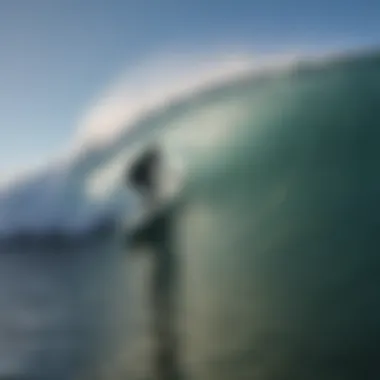Understanding Surfing Traction: Science and Techniques


Intro
Surfing is an enthralling extreme sport that combines skill, balance, and an understanding of natural elements. The essence of surfing hinges on the ability to ride waves, which directly links to an important concept: traction. Traction plays a critical role in performance and safety, influencing how a surfer maneuvers on their board. This article will explore the intricacies of traction in surfing, addressing factors such as board design, the materials used, environmental conditions, and specific surfing techniques.
Overview of Surfing
Surfing traces its roots to ancient Polynesian culture, where it was more than just a sport; it was a vital part of societal and spiritual expression. Today, it has evolved into a global phenomenon with diverse styles and techniques. Surfers use specialized equipment, including surfboards and traction pads, to enhance their experience on the waves. The selection of gear significantly affects one's ability to achieve optimal traction, ultimately influencing performance.
Safety is a paramount concern in surfing. With shifting waves and unpredictable ocean conditions, surfers face risks such as injuries from falls, collisions, or challenging currents. Therefore, it is essential to adopt safety guidelines, which include wearing appropriate gear, being aware of surroundings, and understanding local conditions.
"The ocean is a powerful force; respecting it is integral to becoming a proficient surfer."
Statistics around surfing highlight its popularity, with millions of participants worldwide. Events like the World Surf League's competitions showcase top surfers who embody peak performance and technique. As this sport continues to grow, understanding the principles of traction becomes invaluable for both novice and seasoned surfers.
Foreword to Surfing Traction
Traction in surfing is a critical facet that directly influences both performance and safety. Understanding this concept is paramount for anyone serious about the sport, from beginners to seasoned surfers. Traction provides the necessary grip between the surfer and the board, allowing for better control and maneuverability on the waves.
The importance of traction is multifaceted. First, it enhances the ability to stay balanced. When a surfer can maintain a solid hold on their board, they are less likely to wipe out. This not only improves the enjoyment of surfing but also reduces the risk of injury.
Moreover, effective traction can drastically influence the performance of various maneuvers. Surfers need reliable foot placements to execute turns, speed boosts, and aerial tricks. The right kind of traction allows for a precise distribution of body weight, crucial in mastering complex movements.
In addition, environmental factors like wave conditions and water temperature play a significant role in how traction works. These elements affect the choice of surfboard materials and grip aids, which can be adjusted to match specific surf conditions. Therefore, a solid understanding of traction helps surfers make better choices in equipment and technique.
In summary, traction is not just a technical component; it is a fundamental aspect that impacts every time a surfer rides a wave. By exploring this subject in-depth, the article aims to equip readers with better insight, encouraging them to refine their surfing skills and enhance overall performance.
Key Elements Contributing to Traction
Understanding the key elements contributing to traction is crucial for optimizing surfing performance. Each element interacts with the others, creating a comprehensive ecosystem that directly impacts how surfers engage with the waves. This exploration focuses on how specific attributes of board design, materials, and grip aids enhance traction, leading to better control and safety.
Board Design and Shape
Width and Length Impact
The width and length of a surfboard play a vital role in its overall performance. Wider boards provide greater stability, making them a preferred choice for beginners or surfers who prioritize control. This characteristic allows riders to maintain balance even in turbulent conditions. Conversely, thinner boards can enhance maneuverability, giving advanced surfers the ability to execute sharper turns and advanced tricks. Each choice carries its own benefits and appropriate contexts for use. The challenge remains in selecting the right dimensions based on personal preference, wave conditions, and skill level.
Tail Shape Variations
Tail shape variations significantly influence how a board interacts with the water. Different tail shapes, such as squash, round, and pin, affect how the board releases water and maintains speed. A squash tail, for example, is a popular choice due to its balance between looseness and drive. In contrast, a pin tail offers less surface area for quick turns but provides better control in steep waves. The decision between tail shapes can have a profound effect on the surfing experience, affecting agility and response times when riding.
Materials Used in Surfboards
Polyurethane vs. Epoxy
In the realm of surfboard materials, polyurethane and epoxy present distinct characteristics that influence traction. Polyurethane remains a common choice, largely due to its responsiveness and traditional feel. It offers good buoyancy and durability but lacks the lightweight properties of epoxy. Epoxy boards, on the other hand, are known for being slightly lighter and more buoyant. They allow for increased speed and enhanced performance in challenging conditions, making them a beneficial option for serious surfers. Understanding the strengths and weaknesses of each material allows surfers to tailor their equipment to their specific needs.
Impact of Texture on Grip
The texture of a surfboard's surface has a significant effect on grip and traction. Varying the coarseness or smoothness of the board's surface can manipulate how well surfers maintain their footing. Textured surfaces provide better grip, especially when riding over choppy water or during aggressive maneuvers. This factor enhances both control and comfort, allowing for a more enjoyable experience. Choosing the right texture balance is therefore critical to ensuring optimal performance across various surf conditions.
Grip Pads and Traction Aids
Types of Grip Pads
Grip pads are essential for maximizing traction. Various types exist, each designed for specific conditions and preferences. Simple foam pads offer basic grip but might not perform well under extreme conditions. High-quality traction pads, often made from rubber or advanced composites, provide superior adhesion and are engineered to prevent slippage. Trainers often recommend using pads that match the surface texture of the board for enhanced cohesion. Selecting the right type of grip pad is a crucial decision for any surfer looking to enhance their performance in the water.


Placement Considerations
The placement of grip pads is another important aspect of optimizing surfing traction. Strategic placement can significantly affect a surfer’s control and balance. Standard recommendations suggest location near the tail for shortboard surfers, optimizing for quick movements and tricks. For longboard riders, a more centralized approach may improve stability. Each placement decision comes with its own set of advantages and considerations, making it essential for surfers to experiment and find the adjustment that suits their style.
"Traction is not merely about grip; it’s about confidence in controlling the board and adapting to dynamic conditions."
This section serves as a comprehensive guide to understanding traction’s fundamental aspects, setting the stage for further exploration into the dynamic interplay that defines effective surfing.
Environmental Influences on Traction
Understanding environmental influences on traction is critical for maximizing performance in surfing. This section investigates the various factors at play, including wave conditions, water temperature, and tidal currents. Each aspect complements the overall concept of traction by altering how a surfer engages with their equipment and the ocean.
Wave Conditions
Size and Power of Waves
Size and power of waves directly impact traction. Larger waves generate more force, providing better opportunities for surfers to utilize their board’s grip effectively. The key characteristic here is the energy inherent in larger waves. This energy propels the board forward, enhancing the effectiveness of traction surfaces on the board.
The unique feature of powerful waves is their capacity to create more dynamic movement. Surfers must adapt their techniques to match the wave's energy and size, enhancing their grip by adjusting their foot placement. However, this can also be a double-edged sword; strong waves require precise control, and if a surfer cannot manage their traction, they risk losing balance or even falling.
Surf Spot Characteristics
Surf spot characteristics such as the type of bottom, shape of the break, and surrounding environment play a crucial role in traction. For instance, reef breaks can provide sharper, more consistent waves compared to sandy beach breaks, affecting how a board interacts with the water. The key characteristic here is the bottom structure: rocky, uneven surfaces can alter the way waves behave as they approach the surfer.
A unique feature of these surf spots could be the influence of local currents and wind patterns. Each spot has its own signature, which can enhance or diminish advice given for maximizing grip. Surfers must recognize these variables to maintain effective traction, understanding that poor choices in an unfamiliar surf spot can lead to dangerous situations.
Water Temperature Effects
Impact on Equipment Performance
Water temperature can significantly affect equipment performance, particularly traction pads. Warmer water may cause grips to soften, while colder temperatures can harden them. The key characteristic in this scenario is the texture of traction materials. Softening provides more grip, but also risks wear and tear more quickly.
A unique feature to note is the changing performance of materials. For instance, polyurethane traction pads may react differently in various temperatures, affecting how the board adheres to the surfer's feet. Adjusting to differences, becoming aware of how equipment responds to temperature fluctuations, becomes crucial for optimal surfing experience.
Adjusting Techniques for Temperature
Adjusting techniques for temperature is another aspect often overlooked. A surfer’s foot placement, stance, and overall control must be slightly modified to adapt to water temperature changes. The key characteristic here is flexibility in technique. This adaptability can lead to significant improvement in traction over time.
A unique feature of temperature adaptation is that it encourages surfers to develop a more refined skill set. Surfers familiar with cold and warm temperatures can optimize their approach, ensuring that their techniques yield maximum traction regardless of conditions. Not being adaptable to temperature gives a significant disadvantage, especially for competitive surfers.
Tide and Current Considerations
Managing Traction with Tidal Changes
Tide changes can have substantial effects on the surf’s dynamics, impacting a surfer's traction. Surfs can vary widely at high tide versus low tide, as depths and break patterns shift. The key characteristic of tidal influence is the speed of change in water levels, which can modify wave behavior and momentum.
A unique feature here is how a surfer can manage their traction depending on tidal heights. It is crucial to recognize when to adjust foot placement and body positioning, ensuring maximum board control. Failing to account for tidal changes can lead to ineffective strategies, resulting in missed opportunities to maximize performance.
Adapting to Current Strengths
Adapting to current strengths requires a keen understanding of how currents play into traction strategies. Strong currents can affect the way a surfer rides the wave, influencing the necessary adjustments to maintain grip. The key characteristic is the intensity of the current, which affects speed and movement on the water surface.
A unique feature of understanding current strengths is the ability to anticipate breaks and waves effectively. This anticipation aids surfers in not just maintaining traction but enhancing it. Current-related adaptations can provide a competitive edge, making it essential for surfers at all skill levels to recognize and respond to changing current conditions.
"Understanding the environment is as vital as mastering one’s gear in surfing."


By focusing on these environmental influences, surfers can significantly enhance their traction knowledge and performance. Engaging in continuous learning about how these variables interplay will benefit both novice and advanced surfers seeking to refine their techniques in variable conditions.
Techniques to Enhance Traction
Enhancing traction in surfing is essential for optimizing performance and ensuring safety. Surfers must develop techniques that allow them to maintain control over their board while navigating diverse wave conditions. The following sections explore specific techniques that contribute to better traction, focusing especially on body positioning and turning maneuvers.
Body Positioning
Foot Placement
Foot placement is crucial for maximizing traction on the surfboard. Correct positioning helps the surfer maintain balance and control, enabling sharper turns and more agile maneuvers. The primary characteristic of optimal foot placement is the alignment over the center of the board. This positioning provides stability and allows weight to be equally distributed.
When a surfer places their foot correctly, it allows for better leverage against the paddle of the wave. Riders often find that positioning their back foot on or near the tail increases grip, enhancing control during radical maneuvers. While this placement is beneficial, improper alignment can lead to loss of stability or even wipeouts. It is therefore important to practice and refine foot placement consistently.
Center of Gravity Adjustments
Adjustment of the center of gravity is another critical technique for enhancing traction. A low center of gravity increases stability and control, particularly during dynamic movements on the wave. The key characteristic here involves leaning forward or backward as needed to react to changing wave conditions.
Surfers benefit a lot when they maintain a crouched position. This form lowers the center of gravity, maximizing grip and enhancing balance. However, improperly managing this center during steep drops can lead to falls. Entering waves with the right center of gravity allows surfers to adapt quickly and effectively.
Turning and Maneuvering Strategies
Maximizing Grip during Turns
Maximizing grip during turns is vital for efficient maneuvering on the wave. The technique relies heavily on body positioning, especially during high-speed piviots. Surfers typically carve their turns to distribute pressure across the surfboard, which increases grip on the rail.
The chief characteristic consists of shifting weight toward the edge of the board during turns. This method enhances contact with the water, allowing for better control. Advanced surfers often prefer this strategy as it allows for seamless transitions through high-performance moves. Nevertheless, if weight is shifted incorrectly, the surfer risks losing grip and controlling the turn.
Control through Body Weight Distribution
Body weight distribution is paramount in steering the surfboard effectively. Surfers need to adjust their weight between front and back, which dictates speed and control, especially in critical moments. The ability to control weight distribution helps adjust to the momentum of the wave and influences overall performance.
Surfers prioritize a forward weight bias when paddling into a wave to accelerate efficiently. However, the unique feature of this approach is that surfers are required to find a balance between aggressive paddling and maintaining stability. This technique can be lost in fast-moving waves, leading to instability; thus, practice is essential for mastering it.
The interplay between body positioning and weight distribution is essential for maintaining optimal traction at all times. Succesful execution allows for more versatile and powerful surfing.
Maintenance of Traction Materials
Maintaining traction materials is crucial for optimizing surf performance and ensuring safety on the water. As the primary source of grip on a surfboard, these materials must remain effective to prevent slips and loss of control. This section emphasizes how proper care extends the lifespan of grip pads and other traction elements, directly impacting a surfer’s ability to perform at their best.
Cleaning Techniques for Grip Pads
Frequency of Cleaning
The frequency of cleaning grip pads is essential in maintaining their effectiveness. Over time, pads accumulate sand, salt, and other residues that diminish their grip. It is recommended to clean them after every session or at least weekly, depending on usage. Regular cleaning keeps the pads free from debris, allowing for maximum traction when paddling out or riding waves.
The key characteristic of consistency in cleaning is that it drastically reduces the risk of slip-related injuries. A beneficial routine helps prevent build-up that can cause grip loss. However, surfers must be cautious as excessive cleaning with harsh materials may affect the pads' texture, leading to quicker wear.
Recommended Cleaning Agents
For cleaning grip pads, common household items like warm water, mild soap, or vinegar can be highly effective. These agents are gentle yet powerful enough to eliminate dirt without damaging the grip surface. A distinctive feature of these cleaning agents is that they are widely accessible and often safe for various materials used in grip pads.
An advantage of using these methods is their affordability and effectiveness in daily maintenance. However, avoiding overly acidic or abrasive cleaners is necessary, as they could degrade the pad quality over time.
Replacement and Upgrades


Signs of Wear and Tear
Identifying signs of wear and tear in traction materials is critical. Surfers should look for cracks, peeling, or discoloration on grip pads. These indicators suggest that the pad’s effectiveness may be compromised, warranting replacement.
Recognizing these signs early can prevent accidents that may arise from reduced grip. Frequent inspections and immediate replacements will contribute positively to overall surf performance.
Choosing Replacement Materials
When it comes to choosing replacement materials, surfers must consider various factors such as durability, grip texture, and adaptability to different conditions. Brands like Kicktail and Stomp produce reliable grip pads designed to perform well in various environments. One unique aspect of modern pads is the integration of hydrophobic materials, which help keep the surface dry and sticky.
The benefits of selecting the right replacement materials include enhanced performance and reduced risks. Surfers should prioritize quality to ensure their surfing experience remains safe and enjoyable. However, the misconception that lower-quality materials can be used as a temporary solution might lead to unwanted accidents, reaffirming the importance of investing in high-quality replacement materials.
Innovations in Surfing Gear
Innovations in surfing gear play a crucial role in enhancing overall traction and performance in the water. As surfing evolves, so do the technologies that support it. The integration of advanced materials and design concepts not only improves grip but also addresses safety concerns that come with the sport. These innovations provide surfers with greater control over their boards, allowing for more dynamic maneuvers and safer riding experiences.
Emerging Technologies for Improved Traction
Smart Materials
Smart materials represent a significant advancement in surfing gear technology. These materials can react to environmental changes, such as temperature or humidity, optimizing their properties for better grip. A critical characteristic of smart materials is their ability to change tackiness based on the conditions of the surrounding water. This makes them a popular choice for modern surfboards, allowing surfers to enjoy stable performance irrespective of weather changes.
A unique feature of smart materials is their self-healing capability. If they develop minor scratches or wear, they can regenerate themselves, maintaining the surface texture needed for traction. This not only extends the life of the equipment but also reduces maintenance concerns compared to traditional materials. However, while smart materials provide many benefits, their cost can be a disadvantage, making them less accessible for casual surfers.
Nano-coatings for Enhanced Grip
Nano-coatings are another innovative aspect contributing to enhanced grip in surfing gear. These coatings work at a microscopic level, providing a layer that increases surface friction without adding bulk. One of the key characteristics of nano-coatings is their hydrophobic nature, which repels water, thus maintaining grip even in wet conditions. This feature makes them suitable for all types of surfboards.
The significant advantage of nano-coatings is their lightweight application, ensuring that the overall weight of the surfboard is not compromised while improving safety. A downside is that these coatings can wear off more quickly compared to traditional grip pads, necessitating more frequent applications to maintain effectiveness. Nonetheless, their ability to improve traction dramatically makes them an attractive option for surfers looking to enhance performance.
Future Trends in Surfboard Development
Sustainability in Material Sourcing
Sustainability has become a focal point in surfboard development. Many companies are exploring eco-friendly materials in response to environmental concerns. The significance of sustainability in material sourcing lies in its potential to reduce the ecological footprint of surfing. A key characteristic of sustainable materials is that they often come from renewable sources, decreasing reliance on harmful chemicals and plastics.
The unique feature of sustainable materials is their ability to match or exceed the performance of traditional materials. Companies are developing natural resins and recyclable components without compromising durability or flexibility. However, the primary challenge for sustainable options is their cost, which can be higher than conventional materials. This issue can limit their widespread adoption among budget-conscious surfers.
Customizable Traction Solutions
Customizable traction solutions are gaining traction in the surfing community. These solutions allow surfers to adjust the grip and layout of their traction pads based on personal preferences and specific surfing styles. A noticeable characteristic of customizable options is their modularity; surfers can add, remove, or reposition traction pads to suit their needs.
The advantage of these solutions lies in their adaptability. Surfers can create a setup that works perfectly for them, enhancing comfort and control on the water. Nevertheless, the flip side is the potential complexity that comes with customizing gear, which may discourage less experienced surfers from fully utilizing the benefits.
Customizable traction solutions are revolutionizing the way surfers interact with their boards, leading to improved performance and personalized experiences.
End: The Importance of Traction in Surfing
Surfing traction is a crucial element in achieving optimal performance on the waves. It influences the surfer's ability to maintain control and execute maneuvers with precision. While some may underestimate its significance, effective traction directly affects safety, fluidity, and overall surf experience. A surfer with adequate traction can navigate choppy waters and successfully harness the energy of powerful waves. Conversely, inadequate traction can lead to falls, reduced speed, and ultimately, a diminished surfing experience.
Summation of Key Points
Several key points arise from our discussion on traction in surfing:
- Definition and Role: Traction is defined as the grip between the surfer's feet and the board, affecting how well a surfer can balance and maneuver.
- Board Attributes: The shape, design, and materials of surfboards all contribute to traction. Moreover, grip pads and their placements are vital for enhancing performance.
- Environmental Factors: Wave conditions, water temperature, and tidal changes can heavily influence traction dynamics, necessitating adaptive techniques from surfers.
- Techniques for Enhancement: Proper body positioning and maneuvering strategies can optimize traction, leading to better control and execution of tricks.
- Maintenance Matters: Regular cleaning and timely replacements of traction materials are essential to ensure continued effectiveness.
- Innovations and Future Trends: Emerging technologies such as smart materials and sustainable practices in developing surfboards hold promise for future advancements in traction capabilities.
Encouraging Continued Exploration
The insights provided here should encourage surfers at all levels to delve deeper into the nuances of traction. Understanding how various factors impact this aspect of surfing can lead to improved performance and safety. Furthermore, as technologies evolve, continuous learning about innovations in equipment and materials will be beneficial.
By keeping abreast of developments and experimenting with different techniques and gear, surfers can refine their skills. Community platforms like reddit.com offer spaces for discussions around personal experiences and insights into traction. It is this kind of engagement that fosters growth in the surfing community and enhances the overall surfing narrative. Whether a beginner or an expert, there is always more to discover in the ocean’s depths.



